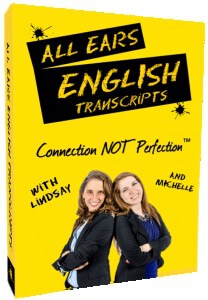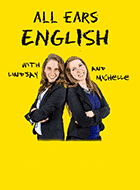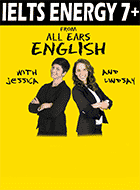Have you ever struggled with the “t” sound in English?
Are you worried about getting your pronunciation right when it comes to certain sounds?
Today we’re looking at instances where “ed” sounds like “t” in English, and this happens more than you might think.
This is a common occurrence and you will see it in several words, and so you want to be sure that you are in tune to this.
We’ll help you to understand how this works, when you might hear it, and how you can bring this knowledge together.
Get Your Transcripts Today!
Make sure you understand every word you hear on All Ears English.
Bring your English to the advanced level with new vocabulary and natural expressions.

Subscribe and get the transcripts delivered by email.
Learn to speak naturally with the American accent.
Click here to subscribe and save 50%
Hi ladies,
I’m hoping you can help me to understand a very common pronunciation in English. This is about the pronunciation of the letter “T” specifically as I know it’s used a lot. Can you please have a session on different pronunciations of letter “T” in American native accent?
I know how the letter should sound in most instances, but sometimes it can be a bit tricky. Most of the time “t” sounds like “d” and I was wondering if there is any reason for that? I just want to be sure that I use this correctly in conversation.
Thanks in advance!
Mitra Rass
Some Background To Help
This is a very common issue, and one that is sure to come up often in conversation.
You might think that you know how a “t” should be pronounced, and then suddenly it sounds very different in certain words.
You can check out our series that we just did on this which is AEE 1543: Tips to Master Pronunciation of the Letter T
We started this series focusing on this very thing, as pronunciation is very important particularly with common words.
Pronunciation can cause miscommunication if you aren’t sure, and this can keep you from making the connections in English that you want.
There are tricky things about English pronunciation to be aware of, and this is one of them.
Sometimes a pronunciation may be quite different than you think, and therefore you may struggle a bit at first.
We are giving you tips in this series to make this process easier, and also ensure that you get the pronunciation right.
If you know how to sound something out and the way that it should be pronounced, then you have a far better chance of getting it right.
Even if you are dealing with a tricky pronunciation as is common in English, you can work through this.
In this series, we are looking at another approach to the letter “t” and this will help you tremendously.
We’re approaching this from a slightly different angle, but still focusing on the letter “t” as it’s so common.
So let’s get into this particular pronunciation, what the sort of rules are here, and how you can master this without making any miscommunication errors.
Looking At The Rule and Tips To Help You
So we’ve talked about the various ways that “t” can take on different sounds in English.
Today we’re looking at when “ed” sounds like t, as this may come up more than you realize.
This is a common pronunciation for a letter that you might not necessarily imagine has this sound associated with it.
So when does “ed” sound like “t”?
The Rule To Keep In Mind
Here are a couple of things to keep in mind to make this easier moving forward.
The Rule
If the verb base ends in a voiceless sound, then the –ed ending sounds like “t.” If a sound is voiceless, no noise is made by the vocal cords. A voiced sound on the other hand, actually uses the vocal cords. A vibration or humming sound is made in the throat—you can picture this if you stop and think about it. Make the letter sound and touch your throat to feel it. This is a very vocal sort of sound and there is evidence to that since you can actually feel it happening in your throat.
Tip To Help
So you can picture this with the sound, and you can even feel this happening in your throat. That helps you to envision how this should work and the sound that you should be creating. You also want to keep this in mind as the “t” is combined with certain other letters and sounds. The “t” is blended together with the previous consonant and not pronounced as an extra syllable.
Examples of How This Works
So now that you have the background you want to put this all into action. You can see this in the following examples, and you can start to get a feel for how this works and the types of words that are affected by it. Think through these letters, the combinations of sounds, and the words that they create together.
P camped, helped, jumped
K cooked, winked, debunked
SH crashed, washed, hushed
CH marched, watched, parched
*GH(F) coughed, laughed
*FF cuffed, huffed
TH birthed, unearthed, frothed
SS hissed, kissed, missed
C glanced, danced, chanced
X mixed, fixed
Keep these examples in mind, as well as the rule and the tip to help you.
This is a good guide to help you through when you feel unsure in any situation, and as you can see this is a sound and combination that comes up quite a bit.
Practice the sound, think through the way that this forms and comes together, and then use these letter combinations and examples as a guide to help you when this appears in conversation.
This will help you to avoid mispronunciation, and therefore ensure that you can stay ahead of things with what to use when you want to use these words.
Roleplay To Help
In this roleplay, Lindsay and Aubrey are talking about an accident that happened.
Lindsay: “The craziest thing happened this morning! I missed the bus, so I took a cab, but then the taxi crashed into a tree!”
Aubrey: “Oh no! Were you hurt?”
Lindsay: “No- luckily it wasn’t too serious and no one was injured. There were people nearby who watched it happen and then helped us out of the car and called the police.”
Aubrey: “Why did the driver hit the tree? They glanced down at their phone, didn’t they?”
Lindsay: “I can understand why you’d assume that, since it seems like every accident is caused by distracted driving. This one debunked that theory though. A jaywalker ran out in front of us and he swerved to miss him. The guy jumped out of the way just in time!”
Aubrey: “I’m glad no one was hurt. I bet you were pretty shaken up though!”
Lindsay: “Yeah, I went home and washed up. I was parched so I got a drink of water. Then I crashed!”
As you can see, there are two very different uses of “crashed” there.
One is used for an auto accident, while the other is used to talk about falling asleep.
Go through the vocabulary used in this roleplay, and you may notice a few things.
You may have noticed some words that end in “ed” there that did NOT make the “t” sound, and this is a great lesson to focus on.
The examples of this include: happened, injured, called, caused and swerved (where ed sounds like d) and distracted (where it sounds like id).
In the next episode of this series, we will share the rules for when words ending in “ed” sound like “d” or “id.”
Don’t miss it because this will help you to focus on the right pronunciation with the right words, and you will be a step ahead of the game.
Takeaway
We don’t want pronunciation to be a stumbling block for you, and so hopefully this series helps to ensure that you are in tune with this.
English can seem so confusing and tricky, but when you break it down and learn why certain sounds are made, it’s much simpler and you can break it down in the perfect way.
Listen to this episode again and practice the pronunciation of these words and phrases.
You will gain confidence as you know you’re pronouncing words correctly, and you’ll be able to join conversations and make those connections in English!
If you have any questions, please leave them below in the comments section.
We’ll get back to you as soon as we can.








